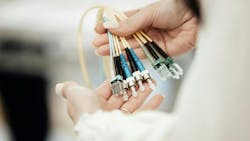A Guide to Fiber Cable Types and Cost for the Industrial IoT
With industrial Internet of Things (IoT) networks constantly changing and evolving, understanding the ins and outs of fiber optic cables is needed for IT technicians and plant managers alike.
Although fiber has been around for more than four decades, many misconceptions remain. At the top of the list is that installing fiber optics is more expensive than copper due to its networking devices, terminations, and cables. Another is that fiber is harder to install and terminate than copper. Last, there's the fallacy that fiber cables are fragile since they're "made of glass".
We'll dispel those lingering myths here.
Fiber optic cables are the fastest-growing transmission medium for both new network builds and expansions, especially in applications that require high bandwidth, long distances, and immunity to electrical interference. Network backbones transmitting huge amounts of bandwidth-consuming data files almost exclusively rely on fiber.
So, is fiber right for your industrial network? Let's find out.
Fiber Optic Cable Construction
As the name implies, fiber optic cables carry optical signals using fast-traveling pulses of light instead of electricity over long distances. At the cable's core are extremely pure glass fibers the same width as human hair that transmit light photons down the length of the cable.
A 0.005 in. (125 µm) layer of glass cladding surrounds the core to guarantee that light is reflected, rather than leaking out at the edges, enabling the signal to travel longer distances without attenuation. Over the cladding is a buffer that keeps the cable's internal glass structure safe from damage and prevents excessive bending. An additional layer of reinforcing fibers shields the core, followed by a rugged plastic jacket.
Durability of Fiber Cables
Fiber is far from fragile. The strength members of fiber cables protect against crushing blows, bending forces, and, of course, the pulling tension encountered during installation. Reinforcing around the core keeps the cable stiff to maintain the allowable cable-bend radius and prevent kinking when pulling around corners. Once installed, fiber optic cables are sturdier than copper with fewer parts. In fact, a fiber optic cable can last up to 50 years, withstanding extreme temperatures, high shock, moisture, and vibration without degrading.
All this doesn't mean careless installation won't damage fiber optic cables. Exceeding bending radius limits or kinking the cable will lead to micro-cracks that increase the potential for degradation. Poorly spliced cable will give rise to fiber movement if splice materials have different characteristics than the cable, such as different thermal expansion coefficients. Malfunctions in fiber optic networks are virtually always due to poor installation, misaligned fusions, or accidental cuts.
Despite the built-in mechanical protection in modern fiber optic cables, some industrial or outdoor plant installations require more protection. In these instances, armored cables are recommended.
Armored fiber optic cables are manufactured to handle abrasion, impact, UV damage, and are designed for underground direct burial out of the box. Armored cables can be a cost-effective alternative to running the cable through a protective conduit. Conduit installation costs are incurred twice: first, when installing the conduit, and second, when installing the cables, hence doubling labor and material costs. Armored cables cost more than standard fiber cables but the labor to install them is considerably less.
Single-Mode Fiber
Fiber optic cables are broken down into two main product categories: single-mode (SM) and multimode (MM).
Single-mode cable has a small diametral core of 0.00035 in. (9 µm) that permits only one mode of light to propagate. SM decreases the number of reflections created as the light passes through its core, resulting in lowered attenuation and creating the ability for a signal to travel several miles before needing to be enhanced. SM is the preferred choice for long-haul networks, telcos, campus backbone, and large enterprises spread over extended areas.
SM is available in two classifications:
- OS1: For use in indoor locations over shorter distances and where electrical interference may be greater.
- OS2: Targeted at outdoor installations with a maximum range of 125 mi (200 km). OS2 cables support bandwidth speeds of up to 400 Gbit/s over distances up to 50 mi (80 km) or further using off-the-shelf optical modules. OS2 is generally more tolerant to flexing and stretching than OS1. Not surprisingly, OS2 cables also tend to be more expensive than their OS1 counterparts.
Multimode Fiber
Multimode (MM) fiber optic cables feature multiple strands, ranging in number from 2 to several hundred, resulting in a wider core (0.002 to 0.0025 [50 to 62.5 µm]) that accommodates the transmission of numerous data streams over one cable. However, the larger core has its limitations.
Due to higher signal attenuation, MM cables are unable to handle the same long distances as SM fiber cables, typically 1 mi (2 km) or less, so they are used to connect in short-range applications.
MM developed with a plastic core may be used in place of glass for certain industries, such as mining or sensing applications, while bigger core diameter fiber (called MM200) is necessary for other applications.
Like SM, MM cables are split into several classifications:
- OM1: Maximum bandwidth of 10 Gbit/s, 100 ft (30 m) distance (obsolete in ISO/IEC 11801 and TIA 568 standards)
- OM2: Maximum bandwidth of 10 Gbit/s, 260 ft (80 m) distance (obsolete in ISO/IEC 11801 and TIA 568 standards)
- OM3: Maximum bandwidth of 10 Gbit/s, 1,000 ft (300 m) distance
- OM4: Capable of reaching 1,300 ft (400 m) at 10 Gbit/s and 40 Gbit/s up to 500 ft (150 m)
- OM5: Like OM4 but uses different colors of laser light to increase support for greater bandwidth up to 200 Gbit/s or even 400 Gbit/s.
MM should not be confused with "breakout" fiber optic cables. Breakout cables are essentially a group of SM or MM jacketed fibers bound together within an outer jacket. A single connector is shared at one end of the breakout cable with individual connectors on the other. Color-coded cables are "broken out" to enable several connections between network devices with different speed ports, while fully utilizing port bandwidth. Consider, for instance, a switch with a 100G port connected to 10, 10G ports. Ideal for patching, breakout cables simplify installation, reduce cable congestion, and improve overall cable management.
Single vs. Multimode
In the past, the general rule was MM for short indoor/same building applications while SM was for long distance links and just about everywhere else. That's changing.
Recently, there's been a big decrease in cost-per-foot for SM cables. Also, the price of SM transceivers has lowered considerably, while their designs have become more resilient; in the past, an attenuator was required, or you'd risk burning out the receiver if the cable was too short for the laser used.
Both these factors have made SM more cost-efficient for indoor/same building applications. With 40 and 100 Gbit/s connections becoming commonplace, SM increasingly makes business sense for new installations and network expansions. Single-mode electronics are still about 30% more expensive than conventional electronics because they require more complex optical processors to create powerful light sources. However, when factoring in the lower costs of SM cables, the overall expense is similar—yet SM's performance benefit is dramatically better. SM supports brighter, more powerful light sources with lower attenuation. Its bandwidth is unlimited, at least in theory.
Although MM comes in five different cable grades, none of them can match SM's limitless bandwidth over short or long distances.
Cost: Fiber vs. Copper
In general, fiber remains more expensive than copper in the near term. However, fiber ends up costing less in the long run after factoring in copper’s overlooked costs, maintenance, interference, risk of tampering, and replacement expense.
There is no question that installation prices for fiber are higher than those for copper due to the skill required for terminations. But as we said earlier, the cost of fiber cable, hardware, and components is declining. In addition, fiber usually requires less than half the networking hardware, has significantly less downtime, and is less expensive to scale and maintain.
Another big plus is that fiber optic cables are immune to electrical noise. Produced by motors, relays, welders, and other industrial equipment, electrical noise can seriously interfere with copper cabling. The more distance that copper cabling travels between two points, the more noise it absorbs and the more the signal deteriorates. Data is also more secure with fiber since it does not radiate signals and is nearly impossible to tap, thwarting a potentially expensive cyber-attack. Importantly, fiber makes upgrading unnecessary as network speeds and requirements escalate.
Installed "first costs" have long been the driving force behind selecting a cabling medium. Frequently, these costs become the reason users choose to deploy copper instead of fiber. But with the price of industrial fiber networks rapidly dropping due to the factors described above, there are now both short and long-term benefits that make fiber a more compelling choice.
A Few Words on Fiber Termination
Many technicians fear that installing fiber connectors on bulk fiber requires a high level of skill to be done correctly. Several years ago, this was true, but today it's not always the case. The old-school way involved solvent glue, lots of small pieces, and hand polishing the tip. Besides being difficult and time-consuming, the precision required by this method led to unacceptable levels of light loss and back reflection when performed by a less experienced technician.
Today there are better ways to terminate bulk fiber like using pre-polished connectors, fusion or mechanical splicing, and fiber optic pigtails allowing successful implementation even for beginners. Network technicians can choose the best termination option for their needs by weighing the benefits of each technique. Of course, they can also order factory pre-terminated fiber optic cables in the lengths needed that have already been tested for plug-and-play deployment. That said, field termination or "on-site" termination requires a trained technician to adhere to industry standards and use specialized tools. The same goes for splicing broken or severed fiber cables to maintain network integrity.
Like any network technology, fiber terminations are not immune to problems even when performed by a professional. Once a termination is complete, the optical signal must be tested to ensure proper connectivity. Routine troubleshooting will help identify any underlying issues without interrupting network service. Contamination of connector end-faces by dust, dirt, and oil is one of the primary causes of signal loss and failure. Poor polishing or incorrect alignment of fibers can also result in signal loss, as can exposure to excessive humidity or caustic chemicals.
Learn more at www.antaira.com.
About the Author
Henry Martel | Field Application Engineer
Henry Martel is a Field Application Engineer with Antaira Technologies. He has over 10 years of IT experience along with skills in system administration, network administration, telecommunications, and infrastructure management. He's also been a part of management teams that oversaw the installation of new technologies on public works projects, hospitals, and major retail chains.
About the Author

Henry Martel
Field Applications Engineer, Antaira Technologies
Henry Martel has over 10 years of IT experience along with skills in system administration, network administration, telecommunications, and infrastructure management. He has also been a part of management teams that oversaw the installation of new technologies on public works projects, hospitals, and major retail chains.
